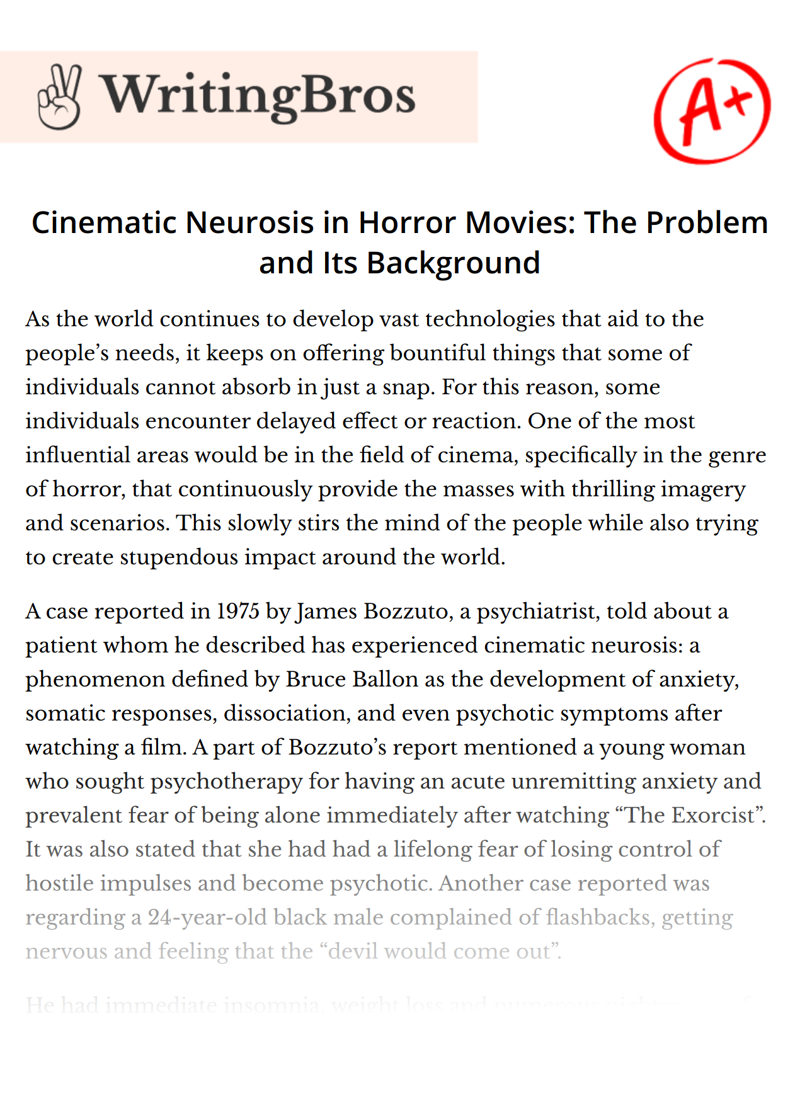Cinematic Neurosis in Horror Movies: The Problem and Its Background

As the world continues to develop vast technologies that aid to the people’s needs, it keeps on offering bountiful things that some of individuals cannot absorb in just a snap. For this reason, some individuals encounter delayed effect or reaction. One of the most influential areas would be in the field of cinema, specifically in the genre of horror, that continuously provide the masses with thrilling imagery and scenarios. This slowly stirs the mind of the people while also trying to create stupendous impact around the world.
A case reported in 1975 by James Bozzuto, a psychiatrist, told about a patient whom he described has experienced cinematic neurosis: a phenomenon defined by Bruce Ballon as the development of anxiety, somatic responses, dissociation, and even psychotic symptoms after watching a film. A part of Bozzuto’s report mentioned a young woman who sought psychotherapy for having an acute unremitting anxiety and prevalent fear of being alone immediately after watching “The Exorcist”. It was also stated that she had had a lifelong fear of losing control of hostile impulses and become psychotic. Another case reported was regarding a 24-year-old black male complained of flashbacks, getting nervous and feeling that the “devil would come out”.
He had immediate insomnia, weight loss and numerous nightmares of vampires chasing women with him interfering. He could not look directly to people’s eyes for the fear that they might imagine them to be devils. The issues became significant in the mental health that it continuous to explore and discover more facts and details about the said cases. In the Philippines, the public is no stranger to these terrifying films.
In an article from CNN Philippines, it was stated that Filipinos are not only quite familiar with the jump scares and suspense of Western horror but also hooked on the excruciating eeriness from Asian horror. In addition, local horror films have their own enticing features as well which could easily undermine its foreign influences. However, despite the abundance of horror films in the market, there is yet to be reports of cases regarding the specified phenomenon in the country.
Horror and thrilling films are starting to create clamor in its field, making it known and giving impact to those who welcome and entertain it. As moviegoers themselves, the researchers have gone through similar sensations after sitting through an entire horror film. It could be as simple as having sleepless nights due to fear of having nightmares about the movie, being afraid to be left alone in the dark in case of unwanted visions, or even to the extent of panic attacks.
With this in mind, in behalf of the masses and those who thoroughly enjoy such films, the researchers intend to identify as to why and how something as seemingly innocent such as a motion picture can cause an unbearable experience to its viewers, as well as to determine how extreme anxiety and fright can progress into a mental illness. Therefore, the study aims to give appropriate information on how cinematic neurosis forms and evolves in individuals upon seeing certain horror and thrilling films.
The researchers firmly believe that motion pictures under the genre of horror and thriller can cause an immense influence on the mental health of an individual. Moreover, the researchers strongly adhere that as these types of movies persist to accumulate in number, the public must also be well knowledgeable of how heavily it can impact mental and physiological stability. This way, they will not only be more aware of the content they choose to consume but also the consequences it comes with. Furthermore, since there are currently little to no studies regarding the said topic, the researchers intend to pioneer this new study that will breathe life into this lost issue.
Cinematic neurosis is a topic that holds a few studies and few theories. Therefore, the researchers will focus on the concept of fear upon seeing horror and thrilling films. One of the few studies that support this notion is the James-Lange Theory of Emotion. William James is a psychologist while Carl Lange is a physiologist. Both independently proposed that emotion is equivalent to the scope of physiological arousal caused by external stimuli. This theory explains that when an individual sees an external stimulus that leads to a physiological reaction, depending on how we interpret those events.
An article posted on Psychology Notes HQ in 2017 cited that people encounter certain situations resulting from physiological reaction such as sweating, muscular tension, increase of heart rate, and many more are produced by the autonomic nervous system. Furthermore, emotions are received and comprehended by the cortex of the brain. The visceral organs and skeletal muscles are stimulated by the autonomic and somatic nervous systems which will then be interpreted as an experience of emotion. The James-Lange theory can be related to the psychological reaction such as fear. For instance, stimuli can be associated to the horror and thrilling films that upon watching them, individuals can experience physiological reactions such as sweating, trembling, or an increase in heartrate.
Another theory that supports the emotion of fear is the Facial-Feedback Theory of Emotion by Charles Darwin and William James. Their theory states that facial movement can influence emotional impact. As people watch horror films with unpleasant imagery and scenarios, these causes changes in their facial muscles which then leads to the shift of emotions such as fear, thrill, panic, and the likes.
The theory of unconscious by Carl Jung can be an essential key to support the idea of fear that people tend to manifest as they indulge in horror movies. The notion of collective unconscious refers to the structures of the unconscious mind which is shared among beings of the same species. According to Jung, the human mind has innate characteristics “imprinted” on it as a result of evolution.
These universal predispositions stem from our ancestral past. This is evident on most people’s inexplainable fear of the dark or creepy places. Thus, whenever individuals encounter scenes that seem eerie in the movie, the initial reaction would be fear. Each theory presented above can be of aid in better understanding on how an emotion such as fear is developed whenever a certain stimulus, such as a horror film, is present.
The researcher’s input of the study is the profile of the participants namely age, gender, degree program, and the number of movies they will be watching. The standard test to be used is the Big Five Inventory by Lewis Goldberg, focusing on the subscale of neuroticism. As for the process of the study, the participants will be asked to watch a few horror films, thereafter the administration and interpretation of the test. Finally, the output where the results of the study will be presented, shall be the basis for the proposed recommendations for cinematic neurosis in watching horror films.
This study will determine whether the act of watching horror films may lead to the development of cinematic neurosis in the students of the Philippine Women’s University for the Academic Year 2019-2020. All participants will be answering Lewis Goldberg’s Big Five Inventory Test. The results of this study will only apply to the enrolled students of Philippine Women’s University for the said academic year.
This study will allow the public to recognize how horror films can influence their physiological and psychological health. This will enable them to be more cautious and more mindful of the content they choose to consume, as well as develop a new level of appreciation towards the art and the media. This study will benefit filmmakers in the production of more horror films in the future. With this study, they will be able to grasp the psychology behind the movies they make, therefore learning what types of scenes, setting, and visuals to showcase in order to attract more moviegoers and entice more audience.
Cite this Essay
To export a reference to this article please select a referencing style below

